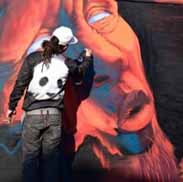AP Biology Practice Exam
Unlock all answers in this set
Unlock answersquestion
Which of the following is true of both mitochondria and chloroplasts? A. They are found in the cells of eukaryotic autotrophs and chloroplasts B. They include stacks of membranes that absorb light C. They include compartments where hydrogen ions are concentrated D. They produce sugars using energy harvested in the cytoplasm E. They break down sugar to produce ATP
answer
C. They include compartments where hydrogen ions are concentrated
question
The tertiary structure and function of a polypeptide is principally determined by the A. length of the polypeptide B. number of nucleotides present in the polypeptide C. repeated units of glycerol making up the polypeptide D. interactions between amino acids present in the polypeptide E. number of introns within the polypeptide
answer
D. interactions between amino acids present in the polypeptide
question
In a species that has five different alleles for a gene at a particular locus, how many different alleles may be present in the somatic cells of one diploid individual? A. one B. two C. three D. four E. five
answer
B. Two
question
If red blood cells cultured in an isotonic medium are placed in distilled water, they will most likely A. remain unchanged B. shrivel C. swell and lyse D. divide E. become dormant
answer
C. swell and lyse
question
The best evidence that the giant panda is more closely related to bears than is the racoonlike lesser panda involves A. comparative anatomy B. comparative embryology C. DNA sequence comparisons D. behavioral similarities E. fossil records
answer
C. DNA sequence comparisons
question
Metabolism of which of the following molecules results in the greatest net usable energy per gram? A. a triglyceride B. a tripeptide C. an alpha-linked disaccharide D. a beta-linked disaccharide E. an anabolic steroid
answer
A. a triglyceride
question
Cells that make up salivary glands would be expected to contain a relatively large amount of A. smooth endoplasmic reticulum B. rough endoplasmic reticulum C. genetic material D. lipids E. peroxisomes
answer
B. rough endoplasmic reticulum
question
Which of the following characteristics distinguishes prokaryotic organisms from eukaryotic organisms? A. Prokaryotes are unicellular, while all eukaryotes are multicellular. B. Prokaryotes are aquatic, while eukaryotes are terrestrial. C. Prokaryotes are structurally less complex than eukaryotes are. D. Prokaryotes require a host to replicate, while eukaryotes do not. E. Prokaryotes lack a cell membrane, while eukaryotes do not.
answer
C. Prokaryotes are structurally less complex than eukaryotes are.
question
An important role of soil microbes in biological systems is the A. recycling of matter B. creation of biomass C. causing of disease D. production of energy E. degradation of energy
answer
A. recycling of matter
question
Which of the following diseases is caused by the lack of a functional gene responsible for a specific enzyme? A. Down Syndrome B. Tay-Sachs disease C. Ricketts D. Malaria E. Influenza
answer
B. Tay-Sachs disease
question
AaBb X AaBb How many different genotypes are possible from the cross shown above? A. 2 B. 4 C. 7 D. 9 E. 16
answer
D. 9
question
All of the following statements concerning the theory of evolution by natural selection are true EXCEPT: A. Organisms produce far more offspring than are required for replacement. B. The individuals in a population show variation in survivability and in their ability to cope with environmental stress. C. The number of offspring that survive to reproduce varies among individuals. D. The bodies of organisms in a population change by use and disuse, and the changes are inherited by the next generation. E. Some of the variation in adaptation is the result of genetic differences that may be passed on to the next generation.
answer
D. The bodies of organisms in a population change by use and disuse, and the changes are inherited by the next generation.
question
Which of the following sequences best represents the life cycle of a typical angiosperm? A. Gametophyte --> meiosis --> gametes --> fertilization --> sporophyte --> spores --> zygote --> gametophyte B. Gametophyte --> gametes --> meiosis --> fertilization --> sporophyte --> spores --> zygote --> gametophyte C. Sporophyte --> meiosis --> gametophyte --> spores --> fertilization --> zygote --> sporophyte D. Sporophyte --> meiosis --> gametophyte --> gametes --> fertilization --> zygote --> sporophyte E. Sporophyte --> spores --> gametophyte --> meiosis --> gametes --> fertilization --> zygote --> sporophyte
answer
D. Sporophyte --> meiosis --> gametophyte --> gametes --> fertilization --> zygote --> sporophyte



